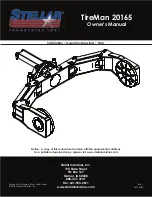
b4 Adventure 4040 Holly Street Unit 10 • Denver Colorado 80216 • 1-844-834-4334
[email protected] · www.slackersline.com/help-center/
303-339-0482 -
DC:062616
3
Étape 3 - Fixez les tubes métalliques courbés du
haut
aux tubes de liaison. Poussez la mousse à
chaque
extrémité des tubes courbés pour exposer
le montage
avec les trous (attention à ne pas
endommager la mousse). Joindre les tubes
ensembles à l'aide de 2
boulons courts à chaque
extrémité. Serrez avec la clé
Allen
(NE PAS TROP
SERRER)
- Figure 4 et 5.
Remettez la mousse à sa
place.
Etape 4 - Prenez les 2 tubes écarteurs verts et une
tige métallique, et enfilez la tige métallique à
travers le tube courbé rouge du
dessus, puis à
travers l’un des écarteurs verts –
Figure 6
.
Au
dessus de la tige métallique, ajoutez un boulon à
tige pour la serrer.
Puis passez la tige à travers le
tubecourbé
jaune, l’autre écarteur vert, et enfin à
travers le tube courbé bleu. Vissez ensuite le
dernier boulon à tige avec la tige métallique du
côté inférieur du tube courbé bleu
. Serrez les
boulons supérieurs et inférieurs de la tige
métallique. Votre partie supérieure devrait
maintenant ressembler à la Figure 7.
Step 3
-
Attach the Top Metal Tube Curves to
the top of the connecting tubes.
Push back the
foam on each end of the curve to expose the
mounting holes (be careful not to damage the
foam). Join
together using
two
bolts for each
curve end.
Tighten with allen wrench
(DO NOT
OVER TIGHTEN!)
-
Figure 4 and 5. Pull foam
back
down into place.
Step 4
-
Take the two green top spacer tubes
and using the Top Curve Connecting metal rod,
thread the metal rod
down through the top red
curve body and then thread the rod through
one of the green spacer tubes - Figure 6.
A
t the
top of the
metal rod, install a single Rod bolt by
screwing it in
.
Then the metal rod will go down
the yellow curve and into the second green
tube, and finally passing down through the
bottom blue curved tube. Screw in the
remaining rod bolt into the bottom of the blue
curve tube
.
Tighten the top and bottom rod
bolts. Your
t
op section should now look like
Figure 7.
2.
JUMPER BOUNCE TUBE INFLATION
2.
JUMPER BOUDIN GONFLABLE
You will need an air compressor (not included) to inflate
your Jumper tube. Do not leave the tube unattended while
inflating.
Vous aurez besoin d'un compresseur d'air (non inclus) pour
gonfler le boudin du Jump er. Ne pas laisser le boudin sans
surveillance pendant le gonflage.
•
Fill bounce tube until tube top is approximately 21
inches from the ground.
•
With a
friend
, lift and place tube
over and onto
tube frame with tube valve pointing
pointing
towards the ground
-
Figure 8.
•
Because the tube is not inside a tire, you cannot
measure the PSI and you will need to do the
following: Have two of the
children start (gently)
bouncing on the opposite
ends of the tube. If their
feet are touching the tube
bottom during this test,
add additional air (no
bouncing while adding air).
Retest and add
additional air until their feet do not
touch the
bottom of the tube while jumping.
•
It is normal for your tube to lose air over time and
may require additional filling.
•
Do not leave tube in direct sunlight. Shade or
use
indoors is the best way to get the maximum
life
out
of your tube.
•
If you over inflate your tube, you may see the tube
bulging in one or more places. While not impacting
the function, it will mean one or more areas will be
higher than others.
•
Remplir le boudin jusqu'à ce que le dessus soit à
environ
53 cm du sol
.
•
Avec un ami, soulevez et placez le tube sur et sur le cadre
du tube avec la valve du tube pointant vers le sol -
Figure 8.
•
Comme le boudin n’est pas à l'intérieur d'un pneu,
vous ne
pouvez pas mesurer le PSI et vous aurez besoin
d’effectuer
les opérations suivantes pour le vérifier :
Deux enfants
commencent (doucement) à rebondir sur
la face des
extrémités du boudin. Si leurs pieds
touchent le fond du
boudin lors de ce test, ajouter de
l'air supplémentaire (ne
pas rebondir pendant le
regonflage). Retester et ajouter de
l’air supplémentaire
jusqu'à ce que leurs pieds ne touchent
plus le fond du
boudin lorsqu’ils sautent dessus.
•
Il est normal que votre boudin perde de l'air au fil du
temps et nécessite un regonflage supplémentaire
•
Ne laissez pas le boudin en plein soleil. Utilisez-le à
l’ombre
ou à l'intérieur pour optimiser la durée de vie
de votre
Jumper
.
•
Si vous gonflez votre boudin plus que la normale, vous
pouvez voir des renflements dans le boudin à un ou
plusieurs endroits. Bien que cela n’est pas d’impact sur
l’utilisation, cela signifie qu’un ou plusieurs endroits du
boudin sont plus élevés que d’autres.
Figure
5
Rod
Connector
Figure 4
Figure 7
Figure 6
F
i
g
u
r
e
8
Connecteur de tige
Top Spacer
Tubes
d’écartement






















